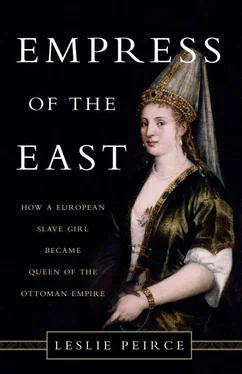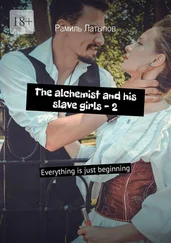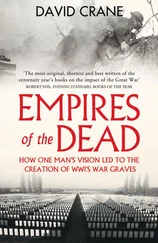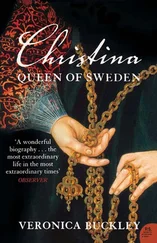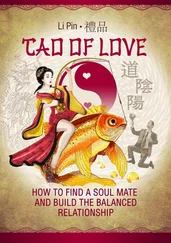of Sigismund Augustus, 224–225
Mecca, 10, 66, 75, 137, 170, 188, 247, 264–265, 265(fig.), 289, 301
de Medici, Catherine, 251, 296, 312
Medina, 10, 170, 264–265, 289, 301
Mehmed (Mustafa’s son), 201–202, 286
Mehmed (son), 105(fig.), 203(fig.)
as intermediary for his mother, 140–141
birth of, 53–56, 72
circumcision of, 102–108, 112–113
combat experience, 202–203, 208–209
competition among princes, 7
death of, 233–237
Mehmed’s education and service, 204
emergence into politics, 110–111
memorial mosque, 238–240
preparation for governing, 122
provincial goverment posting, 214, 216, 218, 226
Mehmed II “the Conqueror,” 86(fig.)
administration, 43
architecture of the New Palace, 131–132
Christian art and relics, 192–193
construction of the harem, 136–137
crisis of succession, 60–61
ending the Karaman-Ottoman wars, 215
financing military expansion, 87
Franco-Ottoman connection, 14
fratricide and violence, 63
hospital construction, 266
marriage of, 198
mosque construction, 239
execution of Mahmud (grand vizier)
New Palace, 12
Old Palace, 27–28
philanthropy, 47, 170–171
remodeling the New Palace, 134
Roman successorship, 160
soldiers’ revolt, 59–60
upgrading the New Palace, 133–134
Menavino Giovanni Antonio, 39, 40, 45, 100, 115, 204
Mengli Giray, 65
Merkez Efendi, 230, 232
Mevlevi order, 228(fig), 228–229
Mihri Hatun, 215
Mihrumah (daughter), 96, 205(fig.)
as female companion, 301
Bayezid’s execution, 306–307
birth of, 58–59, 72, 94, 110
devotion to Bayezid, 309–310
emergence of female patronage, 188
festivities in Adrianople, 261
inherited wealth, 243
marriage of, 205–208
needlework and correspondence, 79
political service, 223, 225, 250, 253–254
relations with Selim, 306–307, 310
upbringing, 11
military campaigns
capture of Rhodes, 58
central Europe, 101
circumcision celebration as display of power, 103–104
construction of the Suleymaniye with the spoils of war, 263–264
Egyptian revolt, 71
German campaign, 101, 163, 219
governance in Suleyman’s absence, 117
governance without, 314
Hafsa following the news of, 113–114
Iranian campaigns, 108–109, 116, 138, 257–258, 260–263, 269–271, 270(fig.), 274, 280, 285–288
maintaining family life during, 141–144
Mehmed’s death cooling Suleyman’s desire for, 237
mock battle to celebrate Egyptian conquest, 107
Mustafa’s education, 82–83
return from Iran (1536), 145
rivalry between Suleyman’s sons, 304–305
Roxelana’s correspondence and counsel, 282–285
Selim I, 63–66
Suleyman’s hiatus from, 71, 219–220
Suleyman’s inherited empire, 10–11
taking and losing Buda, 72–73, 82–83
the princes’ combat experience, 202–203, 222, 275–279
Mongols, 16–19, 60, 63, 77, 117, 146, 215, 227
monogamy, 208
Roxelana’s growing political power, 79–80
Roxelana’s rise as Suleyman’s favorite, 59–60
Selim II’s succession to Suleyman, 311–312
Suleyman’s desire to secure the dynasty, 61–62
Suleyman’s succession of his father, 68
Mosque of the Prince, 238–239
mosques
Hafsa’s mosque (Sultaniye) 113–114
Haseki Avrat, 172–174, 176–177, 182–187, 192
historical debate, 186
Istanbul foundation, 170–171
Istanbul’s built landscape, 46–47
Manisa, 231–232
Ka’aba, 265, 265(fig.)
Mehmed’s memorial mosque, 238–240
Roxelana’s design for, 164–165
sufi spirituality, 228
Suleymaniye, 95, 295(fig.)
Turhan’s mosque, 316(fig.)
motherhood
birth control, 111–112
care of a royal household, 85–86
concerns for the children’s futures, 92
death and difficulties, 72
elevation of status through, 55–57
identity formation through, 91
in the event of a prince’s death, 85–87
issues of succession, 297–299
learning to raise a child, 57–58
professonalizing the offspring, 101
muhaddere (chaste behavior), 126–127
Murad (Suleyman’s son), 35–36, 53–55, 64
Murad II, 14, 60–61, 87, 199–200, 271
Murad III, 238, 296, 309–312, 314
Muscovy, 24, 25, 38
Mustafa `Ali, 152, 239, 308
Mustafa (Suleyman’s son), 105(fig.)
age of provincial service, 57
arrival in Istanbul after Selim I’s death, 93–94
as political threat, 285–286
charge of treason, 269–270
circumcision of the princes, 102–108, 112–113
emergence into politics, 101–103, 108–110
execution, 271–280, 297
formal education, 82–83
harmony with Roxelana, 82
Ibrahim’s part in the rivalry with Roxelana’s sons, 165–166
Iranian campaign, 270–271, 270(fig.)
Janissaries’ admiration for, 240
Mahidevran’s privilege, 83–84
Mehmed’s birth, 55
military and political service, 149–150
mother and status, 35–36
palace criticism of Roxelana, 148–149
provincial government, 208, 222–223
public opinion, 7–8, 271–272, 275, 290
relationships with Suleyman, 95
rivalries among the princes, 10, 62, 73
naval forces, 73, 219
See also Hayreddin Barbarossa
nedim (boon companion of the sultan), 167–168
needlework, 39–40, 79, 252, 255
New Palace
architecture of, 128–131, 130(fig.), 131–133, 132(fig.), 134–135
female quarters, 45–46, 136–137
illustration, 49(fig.), 130(fig.), 132(fig.)
kitchens, 132–133
queen mother’s apartments, 311(fig.)
reflecting the power of the empire, 133–134
residents and offices, 29–30
Roxelana’s domestic responsibilities, 241–242
Roxelana’s residence in, 114–115, 121–125, 127–128, 136
Novosiltsov, Ivan, 26
nuclear family, Roxelana’s, 6, 72
Nurbanu (Selim II’s concubine), 238, 295–296, 311–313
Oghuz Khan, 17
Oliviera Despina, 198–199
Old Palace
education of the women, 41
fire in, 212–213
Hafsa’s status, 34–36
hierarchy of, 27–29
history of, 27–28
princes’ education, 45–46
role of princesses, 37–38
Roxelana’s arrival, 34
Roxelana’s domestic responsibilities, 241–242
pages (sultan’s), 78, 89, 129, 135, 138, 202, 247
Palestine, philanthropic endowment in, 288–294
patronage, political and personal, 155–156
patronage, royal, 171–172, 185–189, 191, 231, 267, 292. See also philanthropy
Peçevi, Ibrahim, 108, 113, 157, 161, 178, 204, 211, 234, 255, 270, 294, 308
philanthropy
in Aleppo, 261–262
as obligation for Muslims, 170–171
emergence of female patronage, 187–188
for sufi piety, 229–230
Hafsa’s foundation, 187, 232
Hatuniye foundation, 231
history of royal building, 194
hospital construction, 264–269
in religious sites, 264–265
Manisa, 232–233
personal meaning of, 191–192
Roxelana’s concern for Janissary welfare, 240–241
Roxelana’s endeavors in Palestine, 288–294
Roxelana’s imperial affairs, 127
Roxelana’s Istanbul foundation, 146–147, 171–172
Roxelana’s political and personal status, 188–189
See also Haseki foundation
Pilak Mustafa, 203, 211–212
pilgrimages, 188, 261–262, 264–265
poetry and poets, 8, 74, 143–144, 147–148, 162, 168, 215, 278, 305
Читать дальше
